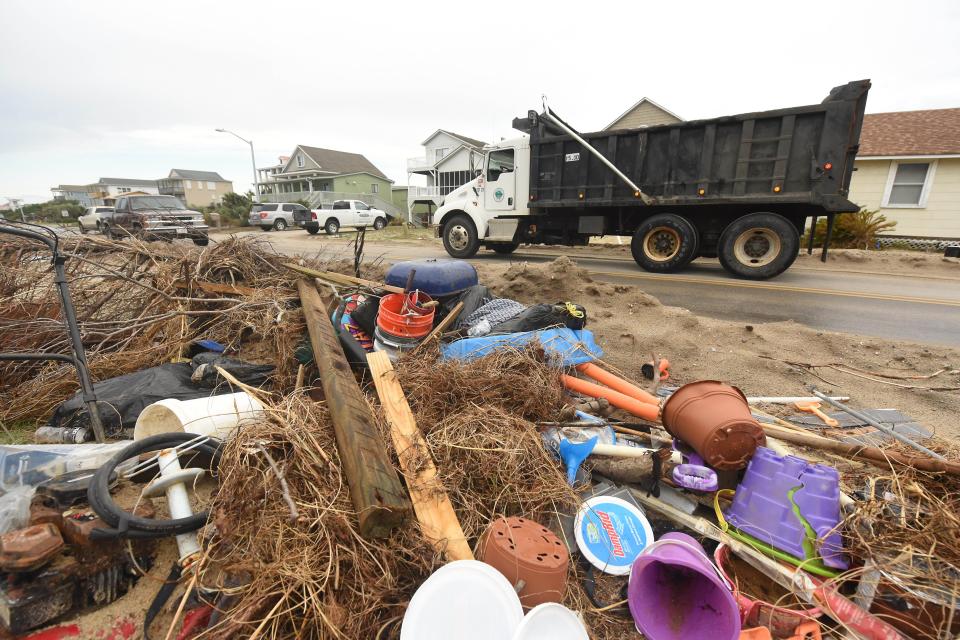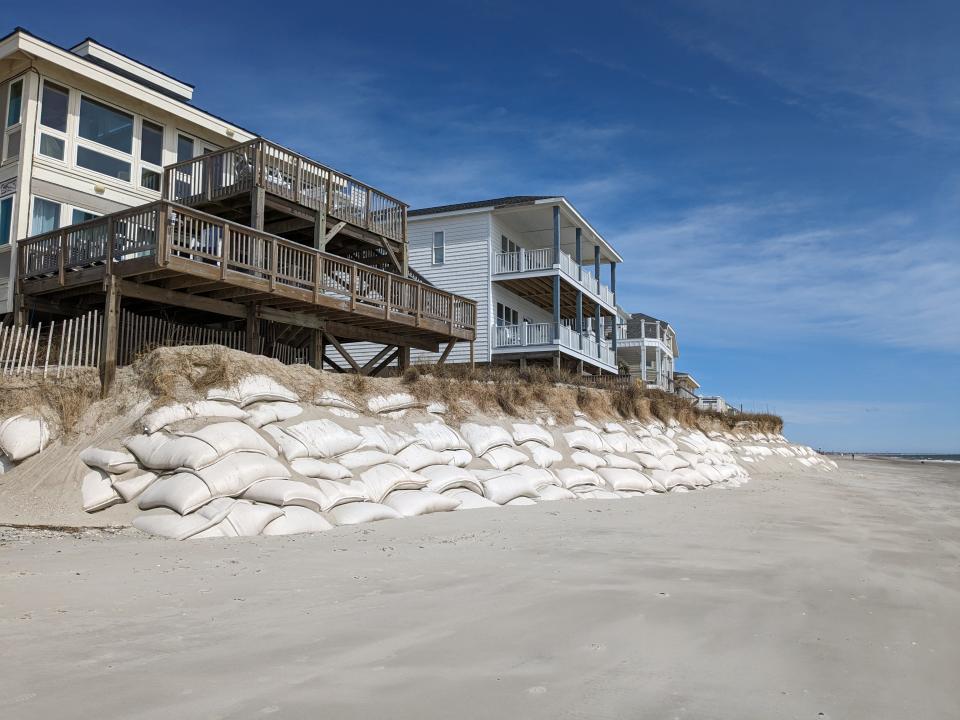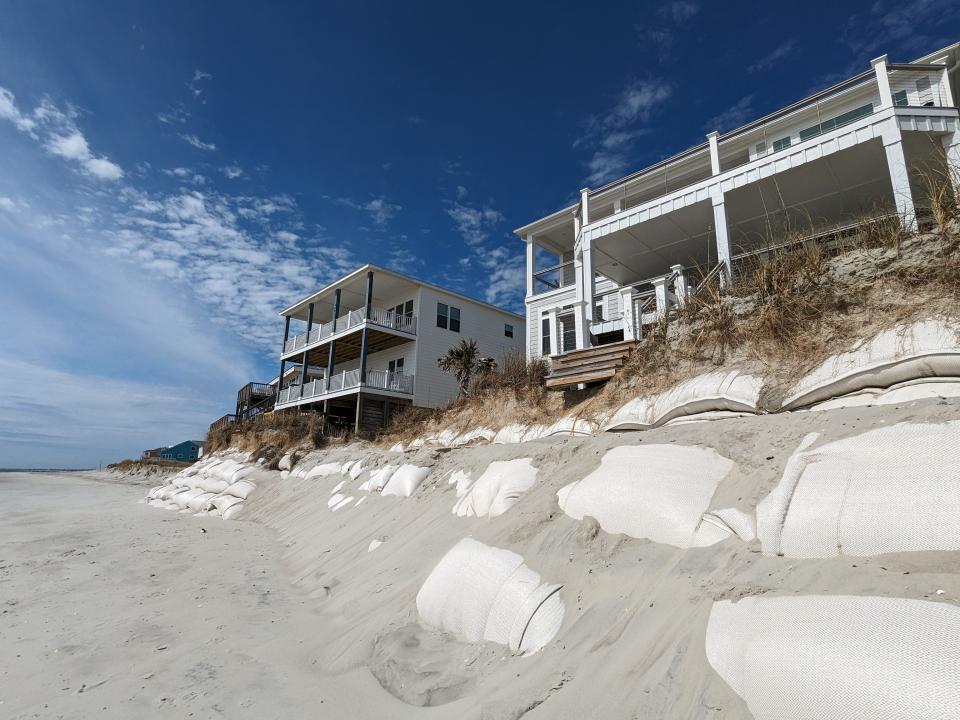Why Oak Island is looking 18 miles off its coast for sand to nourish its eroded beach
Not for the first time, the west end of Oak Island needs sand.
Hurricane Isaias, which raked the Brunswick County shoreline nearly four years ago, chewed away a lot of the beach. Storms, king tides and gradual sea-level rise has since then added to the pain.
But there isn't enough available beach-compatible material near shore, or sand that isn't already planned for other projects, to support a large-scale nourishment.
That has Oak Island officials eyeing a 250-acre borrow site as far out as where gigantic energy-producing offshore wind turbines are planned to help stabilize and rebuild much of the town's beach even as they also potentially look toward a more permanent solution for the erosion-prone area near Lockwood Folly Inlet − namely a terminal groin.
On Feb. 2, the Brunswick County beach town submitted a permit application to the U.S. Army Corps of Engineers' Wilmington district office seeking approval for a project this winter to stabilize and rebuild much of the beach's dune line. The offshore borrow site would be the primary source for the proposed 3 million cubic yards of material, with sand from the mouth of the Cape Fear River, dredged by the corps as part of the Wilmington Harbor project, as a potential secondary source.
"The proposed project is primarily a berm designed to provide advanced fill for a 6-year renourishment interval," states the town's application.
But what makes this project potentially unique, and expensive, is where Oak Island is eyeing to get the majority of its sand. The island is looking at mining a borrow site roughly 18 miles offshore as the primary source for sand. That will require the sand to be mined and transported close to shore by a hopper dredge before it can be placed onto the beach, a much more expensive method than simply pumping sand via pipes from nearby channels or inlets onto a beach.
To put that in perspective, sand for the federally funded Wrightsville Beach nourishment project that is currently wrapping up came from Masonboro Inlet after a prolonged tug-of-war with federal and environmental officials over using sand from a site in a Coastal Barrier Resources Area (CBRA) zone. If that appeal by the town had failed, it was eyeing a borrow site roughly three miles offshore.
Farther up the coast, Topsail Beach used sand from New Topsail Inlet and nearby channels for its roughly $25 million project this winter.
Because the proposed Oak Island sand source is in federal waters, beyond the three-mile jurisdictional limit of North Carolina's state waters, the federal Bureau of Ocean Energy Management (BOEM) is coordinating with the Corps on the application review.
PHOTOS: Hurricane Isaias damage in Brunswick County from the air
Continual nourishment
Oak Island's first beach nourishment project took place in 2001 in response to damage from 1999's Hurricane Floyd.
Since then, the town has been reliant on sand-pumping projects to keep its beach wide enough to entice tourists and protect expensive oceanfront property, especially near the 9-mile-long beachfront's western end.
In 2009, material from a corps' project to dredge the Lockwood Folly Inlet crossing of the Intracoastal Waterway was placed on the island's west end. Then in 2015, a town-funded dredging project around the inlet saw more material placed on the beach.
After Hurricane Matthew washed away many of the island's dunes in 2016, a town-sponsored dune restoration project saw fresh sand pumped along 4.4 miles of beachfront. This was followed by another dune-restoration project in 2022 after 2018's Hurricane Florence washed away much of the earlier material.
Yet two years later, the beach is in dire straits again.
SAND WARS: The potential fight over the coast's most valuable resource

Heavy taxpayer burden
The constant need for sand, which has to be largely funded by town taxpayers with potential help from the state, since Oak Island isn't part of a federal nourishment project like New Hanover County's three beach towns − although town officials would like to see that changed, is grating on town officials.
At the town's annual retreat workshop in January, Oak Island officials lamented the burden on town taxpayers of periodic nourishment projects that seem to be doing little than holding the line on erosion − while offering no long-term solution.
That prompted town leaders to ask members of their engineering firm, Moffat & Nichol, if a terminal groin was a viable, cost-effective option or at least one that should be studied. Ocean Isle Beach and Bald Head Island have built terminal groins, which as hardened structures were illegal along the N.C. coast for decades until 2011, and North Topsail Beach has been mulling one for the severe erosion problems it faces around New River Inlet.
Moffat officials, however, warned that any groin project would take years of studies before construction could begin, and the building and future maintenance of the structure would be expensive.
But Mayor Elizabeth White said simply pumping sand onto the beach to then watch it progressively wash away was frustrating, so maybe studying a terminal groin should be on the table.
"Until we begin that conversation, look forward, we will perpetually be in the sand nourishment business, which is not very satisfying for the taxpayers," she said at the workshop.
This winter's proposed nourishment project is estimated to cost $40 million, with $20 million of that covered by a one-time state grant and the rest funded by Oak Island.
If the town sticks with just pumping sand to keep the encroaching ocean at bay in the future, that cost is likely to balloon dramatically since the most promising sand source for the long-term, 50-year beach nourishment project that the town is looking to implement is Frying Pan Shoals. While a rich reservoir of sand, the wandering shoals − which helped give Cape Fear it's fearsome name thanks to the number of ships the shallow waters claimed − is more than 25 miles offshore.
The shoals also are a rich maritime ecosystem that has never been mined for sand before. That uncertainty around potential environmental impacts prompted BOEM to partner with the University of North Carolina Wilmington (UNCW) on a $2 million project to study the idea.
“Our region is at a deficit for sand,” said Dr. Joe Long, director of UNCW's Coastal Engineering program in a release last October announcing the collaborative project. “UNCW is perfectly poised to provide data and models that can be used by BOEM to help determine if Frying Pan Shoals is a viable source for sand mining, and if it can be done safely and effectively without harming the important ecosystem.”
FRYING PAN TOWER REBORN: Battle underway to restore famous offshore light station

'Doing nothing equals disaster'
With several studies and beach projects underway or planned, the cost of maintaining Oak Island's beach and the pressure that will add to the town's finances is likely to only increase in the coming years. Yet the Brunswick County beach town, like many of North Carolina's beach communities, is finding itself stuck between a proverbial rock and a financial hard place.
The beach draws people to the town, keeps property values high, and drives the local economy.
But as seas continue to rise as the planet warms and climate change brings more unpredictable weather patterns and powerful storm systems to coastal areas, the cost of protecting the beach and oceanfront homes is expected to increase dramatically. Some communities along the Outer Banks are already struggling with this reality after Dare County said it simply doesn't have the money to fund beach nourishment projects along all of its barrier islands and the federal government has shown little appetite to step into the funding breach.
Even Bald Head Island, a wealthy enclave on the other side of the Cape Fear River from Oak Island which has roughly 300 full-time residents, has had a healthy debate over the rising costs of maintaining its 14 miles of shoreline. Along with receiving sand from the dredging of the Cape Fear River shipping channel every few years, the village performed its own shoreline projects in 2010, 2016 and 2018. It also built an $18 million terminal groin last decade, and voters this month approved funding another beach nourishment project, estimated to cost around $18 million, in 2025.
COST OF NOT RETREATING: Study says buyout of threatened Outer Banks homes would be cheaper than beach nourishment

Then there's the issue of finding beach-compatible sand, which is becoming its own thorny problem as nearly all North Carolina beach towns explore nourishment projects amid a limited supply of easily accessible material close to shore.
White said changing state law, which largely limits the erosion-fighting tools in the toolbox for beach towns to periodic nourishments, could help provide more options. Educating the public that beach-building projects aren't just to protect rich oceanfront property owners also could help make future costs a little more palatable.
“The damage to infrastructure, homeowners, the loss of property extends far beyond the front row,” White said, noting the widespread damage Isaias caused.
At the workshop, Councilman John Bach stated the situation facing the town more succinctly, noting that sitting by and hoping for the best isn't a strategy.
"Doing nothing equals disaster," he said. "There is no doubt that this community as we live in it today will not exist if the beach is devastated."
Reporter Gareth McGrath can be reached at GMcGrath@Gannett.com or @GarethMcGrathSN on X/Twitter. This story was produced with financial support from the Green South Foundation and the Prentice Foundation. The USA TODAY Network maintains full editorial control of the work.
This article originally appeared on Wilmington StarNews: Oak Island beach nourishment could draw sand from far offshore

